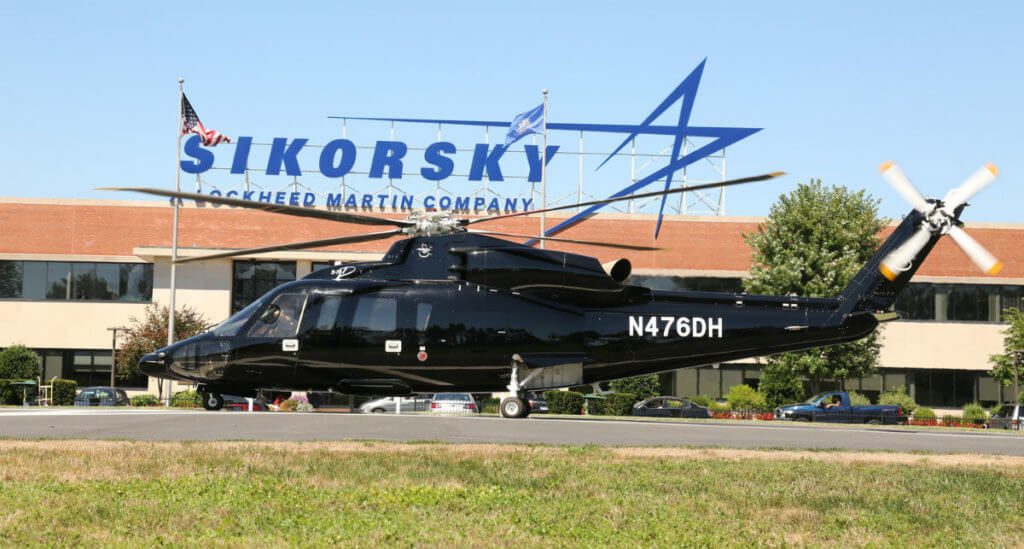Estimated reading time 6 minutes, 57 seconds.
When the Sikorsky S-76 first appeared in Canadian skies, its sleek lines, comfortable and well-appointed cockpit and cabin, and wheeled undercarriage set it apart from other commercial helicopters of the time.

The S-76 helicopter has been in continuous production for more than 37 years, but at least once a decade Sikorsky engineers have updated the helicopter with a newer engine and/or avionics to keep it competitive.
Over its lifetime, the S-76 has been powered by various engine families to enhance performance, range and reliability: Rolls-Royce (250-C30S), Safran Helicopter Engines (Arriel 1S/1S1/1S2/2S2) and Pratt & Whitney Canada (PT6B-36/37 and PW210S).
Earlier this month, Fig Air of Toronto signed to buy a Sikorsky S-76D, becoming the first Canadian operator of the latest generation S-76.
Historically, the executive helicopter market in Canada has always been very small, but with the delivery of this latest example the corporate S-76 fleet in Southern Ontario will have increased five-fold since the summer of 2014.
Fig Air has been flying a corporate Leonardo Helicopters AW109 Grand from Toronto Pearson Airport since 2013. The company was set to become the first Canadian customer for the new 4.6-tonne Leonardo Helicopters AW169, but it bought the 5.3-tonne S-76D instead.
The S-76D first flew in Florida on Feb. 9, 2009, and was certified by the Federal Aviation Administration on Oct. 12, 2012. The first fully configured S-76D was delivered in early 2014.
Fig Air bought a new S-76D that has logged only production test flights from the factory in Coatesville, Penn.
Better performance
The S-76D delivers a whole lot more performance, less noise and a better cockpit than the corporate S-76C+ that is popular in the Ontario market. Its new engine and rotor system performs better overall, including with higher payloads under Cat A operating conditions.
The S-76D is powered by a pair of 1,050-shaft horsepower (shp) Pratt & Whitney Canada PW210S engines which deliver better fuel efficiency than the 922-shp Arriel 2S2s that power the S-76C++, and more power than the 1,000-shp P&WC PT6B-36 in the S-76B, with P&WC recently escalating the TBO (time between overhaul) to 4,000 hours.
The S-76D’s all-composite, flaw tolerant main rotor blades draw on the S-92 blade design and have a new airfoil, wide chord, and swept tip to provide more lift. The tail rotor blades have a wider chord and turn more slowly, resulting in lower noise.
The cabin features an active vibration control system to provide pilots and passengers with a quieter and smoother ride. The cockpit features Thales TopDeck avionics with four 6 x 8 inch flat panel displays, and standalone health and usage monitoring system (HUMS), enhanced ground proximity warning system (EGPWS) and traffic collision avoidance system (TCAS), with a cockpit voice recorder (CVR) standard on all aircraft. The slightly smaller instrument panel provides better pilot visibility and legroom.

Sikorsky decided to hold the maximum takeoff weight at 11,875 pounds to provide better hot and high performance; this is also useful during Cat A takeoffs from helipads.
Going corporate
MacMillan Bloedel Limited, the B.C. forestry company, introduced the first corporate S-76A in Canada in the fall of 1986 to reach its mill sites on Vancouver Island. An S-76C was added to the fleet in 1998.
In Ontario, AIC bought an S-76C in 1999 and built a heliport at its headquarters in Burlington, Ont., also utilized by a corporate AW139 and an S-92 that spends time in Jamaica.
In the past two years, the corporate fleet in Southern Ontario has grown from one S-76 to five, including the S-76D, with a couple more S-76s reportedly on the way.
“You can get a lot of aircraft for the dollar,” said one corporate aviation executive familiar with the corporate helicopter market. “I don’t think this was a case of one company buying an S-76C+ and suddenly everyone else wants one. The S-76 has great capabilities and the prices are attractive, but you really need a team of experienced pilots and mechanics because this is a sophisticated aircraft.”
There are two S-76C+ aircraft managed by Partner Jet and NovaJet at Toronto Pearson Airport (where Fig Air will be based) and another S-76C+ owned by La Tour Aviation and flown from Lake Simcoe Regional Airport. That particular aircraft was based in the U.K. and flew the British Royal Family, including the Queen, from 1999 to 2008.
Elsewhere, HNZ Group’s Canadian Helicopters has been flying an S-76A for a Montreal-area client for many years, and 3D Helicopters (owned by Mark Dobbin) has an S-76A in Newfoundland and Labrador for corporate and charter use.
Canadian service
Canadian operators have flown the S-76 on a wide range of missions at home and abroad.
The helicopter has supported offshore drilling rigs, served as an executive transport and an air ambulance, and was employed as a dedicated maritime search-and-rescue aircraft. Helijet has also utilized the S-76 as a scheduled transport helicopter serving the Vancouver-Victoria route. Finally, Coulson Aviation and Summit Helicopters have flown B and C variants in support of aerial firefighting operations.
To help develop Canadian aircraft maintenance capabilities on the S-76, Sikorsky donated a helicopter to Canadore College in North Bay a few years ago.
With the appointment of Skyline Helicopter Technologies near Sudbury, Ont., as its first S-76 customer support centre in Eastern Canada–as well as the selection of a dedicated Canadian sales representative–Sikorsky has shown it is increasingly committed to growing Canada’s S-76 family.









Very pleased with the accuracy and positive message of this article
Ken good concise article on the 76 and variants.
Thanks Gary … just like your articles 😉